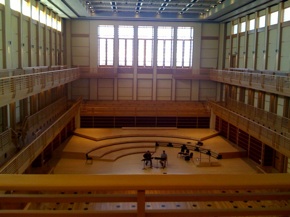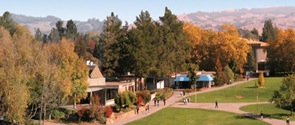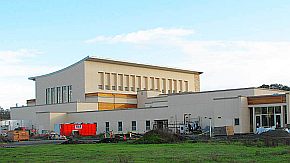Although the Green Music Center, located at and managed by Sonoma State University, has no connection with the target of the raid, the SSU’s California Institute of Human Services (shut down under another cloud in 2007), the affair still can hurt it. It’s been hard enough in these economically parlous times for the Center’s supporters to raise the $14 million outstanding on the $110 million cost, or at least the $6.7 million needed by this summer in order to purchase the 1,400 chairs and complete the lobby and restrooms so that the Center can open in September 2011.
 Whether or not the investigation and the possible prosecution by the Sonoma District Attorney, California’s Attorney General, or the U.S. Attorney’s office result in a fraud conviction, doubts have been raised about the SSU’s administration under President Ruben Armiñana. Apparently, proper oversight of that Institute was not provided, raising allegations in 2007 that are now being investigated: that federal and state grant money may have been misused. Yesterday, Eduardo Ochoa, SSU’s Provost and Vice President for Academic Affairs who has the responsibility for the Green Music Center, confirmed to SFCV that when SSU discovered the problems, it closed the Institute and dismissed its two top administrators, Tony Apolloni and George Triest. No charges were filed against them.
Whether or not the investigation and the possible prosecution by the Sonoma District Attorney, California’s Attorney General, or the U.S. Attorney’s office result in a fraud conviction, doubts have been raised about the SSU’s administration under President Ruben Armiñana. Apparently, proper oversight of that Institute was not provided, raising allegations in 2007 that are now being investigated: that federal and state grant money may have been misused. Yesterday, Eduardo Ochoa, SSU’s Provost and Vice President for Academic Affairs who has the responsibility for the Green Music Center, confirmed to SFCV that when SSU discovered the problems, it closed the Institute and dismissed its two top administrators, Tony Apolloni and George Triest. No charges were filed against them. The administration has been under a cloud since 2007, when the faculty, in a no-confidence referendum, expressed its dissatisfaction with the leadership of Armiñana, president since 1992. The faculty specifically focused on “a pattern of unwise university financial practices.” The chancellor of the California State University system, Charles Reed, took no action at the time, but now, after last week’s raid, was quoted as welcoming the investigation that he said he had been seeking for three years. Ochoa said that SSU did have complete audits made from inside and outside at the time and had requested an investigation two years ago but that this was not forthcoming. The university had no advance knowledge of the warrant that triggered last week’s raids.
Foundation Being Scrutinized
The State Attorney General, investigating yet another problem at SSU, is auditing the school’s Academic Foundation, looking into its more than $20 million in private real estate “loans.” Of that, $9 million in seven investments (described as “loans” in the newspaper stories) were made with a real estate tycoon, Clem Carinelli, who last month filed for bankruptcy, the biggest in the county’s history. Ochoa described these investments as having been made or approved by the foundation board, responsible for the university’s endowment. They were funding vehicles to develop higher returns, which they did. Only one is in default, according to another spokesperson at the university. Carinelli, the largest single landholder in the county, saw his holdings fall from $466 million to $196 million in two years and, since 2008, drop to the bankruptcy level. The relevance of this to the Green Music Center is its effect on discretionary wealth in the county. Certain of the Center’s donors, having lost money in investments with Carinelli, are less well-positioned to add to their contributions.
Aside from the fund-raising challenge, the Center finds itself without an executive director. Floyd Ross, who held that title since the project’s inception, retired last month. At this critical point, it seems essential to find a successor who has the personality and presence to provide strong leadership, broad knowledge, and experience in the performing arts and the music industry in order to program the hall and project a booking plan well in advance of opening, and to direct its operation. Ochoa said that the search has been put on hold pending clearer knowledge of the opening date. Ross had worked in tandem with Jeff Langley, the center’s artistic director, who remains in that position.
The leaders of the Santa Rosa Symphony, the principal and, at this point, sole resident constituency in the Center-to-be, are said to be considering assuming control and operation of the Center from the university, or taking a major share of it. Whichever conducts the search for a new and stellar executive director — either or both the university or the symphony board that has already produced from its patrons a major share of the financing — it would seem imperative to get top-flight, professional guidance from an outside, disinterested specialist. In its early stages, a consultant, Welz Kauffman, president and CEO of the Ravinia Festival, was engaged to advise about the requirements of mounting the first seasons, Ochoa said. Now there are very different needs.
Center Holds Major Promise
The Green Music Center is a much more important project with a greater potential and mission than even its supporters may envision. It is in a beautiful location, with views to the east unmarred by housing tracts or business developments such as those the Marin County Supervisors permitted to erupt north of its Frank Lloyd Wright–designed Civic Center, violating its earlier promise not to do so. It boasts a hall that bids fair to be the finest symphony and concert hall in Northern California, and already is the most attractive and inviting (see review). The ancillary facilities are first rate, including a more than ample, immediately accessible parking lot and fine newly completed dormitories already used in the summertime to house participants in special workshops at the center.
The summertime use is most appealing. The back and side of the hall can be opened to a grand lawn available for a large supplementary audience. There has long been a certain yearning in the Bay Area for a summer festival venue. Clark Kerr dreamed of a “Tanglewood” at the University of California when he was chancellor and later, president. The Greek Theater on the Berkeley campus did not work out because of the fog and chill in the summer nights. The quarry on the UC Santa Cruz campus was the next target — never happened. Stanford ran its splendid summer music festival successfully in the late 1960s, giving it up for financial reasons and in favor of other priorities. The San Francisco Symphony dreamed of a summer festival, and its esteemed and longest-serving officer (vice president), the late Agnes Albert, offered her famed family property on the Peninsula, House on Hill, but that never happened. The Concord Pavilion, planned as the region’s summer festival destination, had what it took physically, but never caught on.
The Rohnert Park site of the Green Center has it all, making programming and producing such a festival there almost self-evident. It could be the San Francisco Symphony’s Tanglewood, Ravinia, Blossom Festival, or Robin Hood Dell. Of course, the Santa Rosa Symphony could extend its performing through the summer. There are numerous other possibilities, including an expansion of the current summer workshops into something like the very successful amateur chamber music summer workshops at Southern Oregon State University in Ashland, in San Diego, and in Chico. The educational programs that should be built into the Center’s program during the school year could be developed further in the summer, as could master classes.
Most important of all is the symbolic and morale-boosting function of such a cultural center for the county. If only the 170-member Sonoma County Vintners in Santa Rosa were to realize how this Center could help make their 250 wineries and the county a destination to rival the neighboring Napa County, the campaign to finish the job might just go over the top.
